Abstract
The thermodynamics of the binding of derivatives of galactose and lactose to a 14 kDa beta-galactoside-binding lectin (L-14) from sheep spleen has been studied in 10 nM phosphate/150 mM NaCl/10 mM beta-mercaptoethanol buffer, pH 7.4, and in the temperature range 285-300 K using titration calorimetry. The single-site binding constants of various sugars for the lectin were in the following order: N-acetyl-lactosamine thiodigalactoside > 4-methylumbelliferyl lactoside > lactose > 4-methylumbelliferyl alpha-D-galactoside > methyl-alpha-galactose > methyl-beta-galactose. Reactions were essentially enthalpically driven with the binding enthalpies ranging from -53.8 kJ/mol for thiodigalactoside at 301 K to -2.2 kJ/mol for galactose at 300 K, indicating that hydrogen-bonding and van der Waals interactions provide the major stabilization for these reactions. However, the binding of 4-methylumbelliferyl-alpha-D-galactose displays relatively favourable entropic contributions, indicating the existence of a non-polar site adjacent to the galactose-binding subsite. From the increments in the enthalpies for the binding of lactose, N-acetyl-lactosamine and thiodigalactoside relative to methyl-beta-galactose, the contribution of glucose binding in the subsite adjacent to that for galactose shows that glucose makes a major contribution to the stability of L-14 disaccharide complexes. Observation of enthalpy-entropy compensation for the recognition of saccharides such as lactose by L-14 and the absence of it for monosaccharides such as galactose, together with the lack of appreciable changes in the heat capacity (delta Cp), indicate that reorganization of water plays an important role in these reactions.
Full text
PDF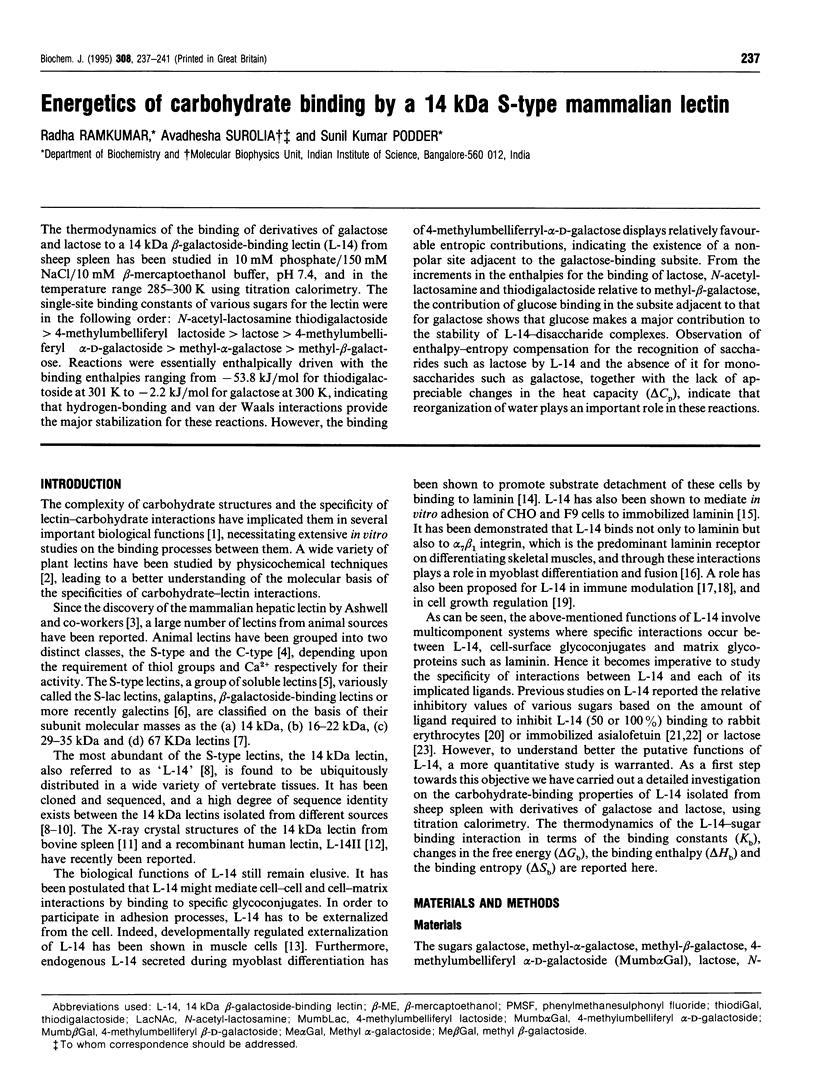
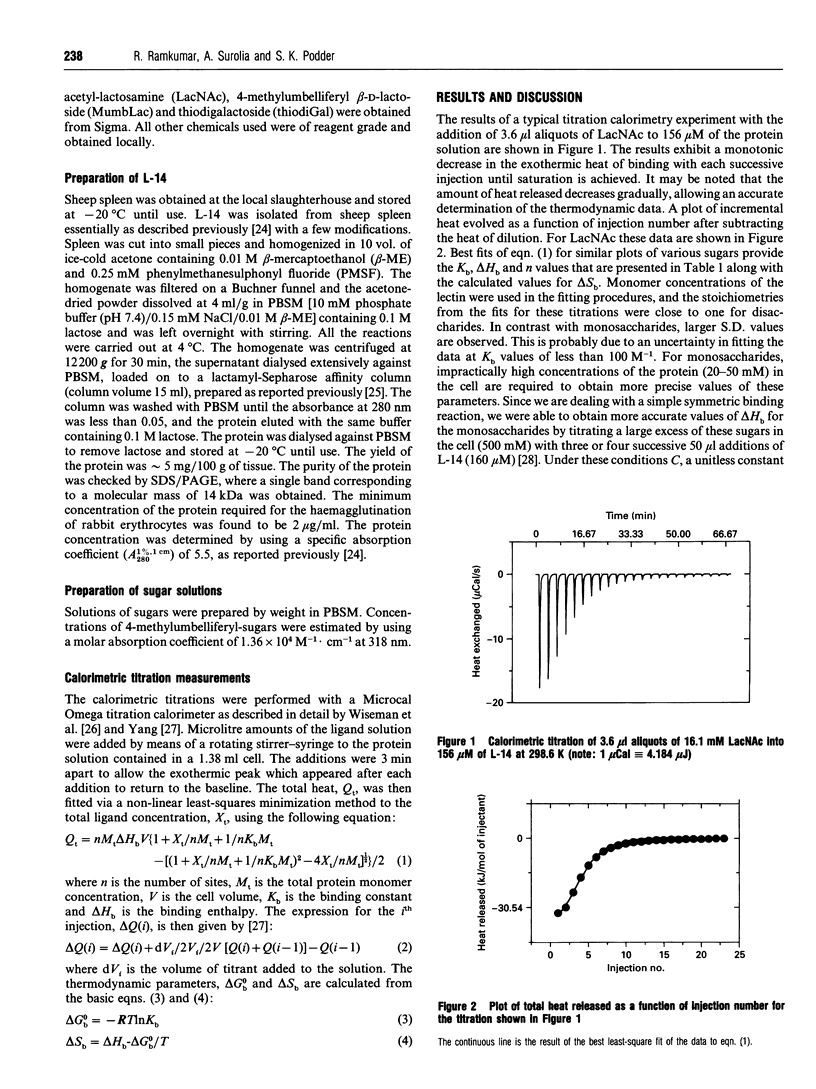
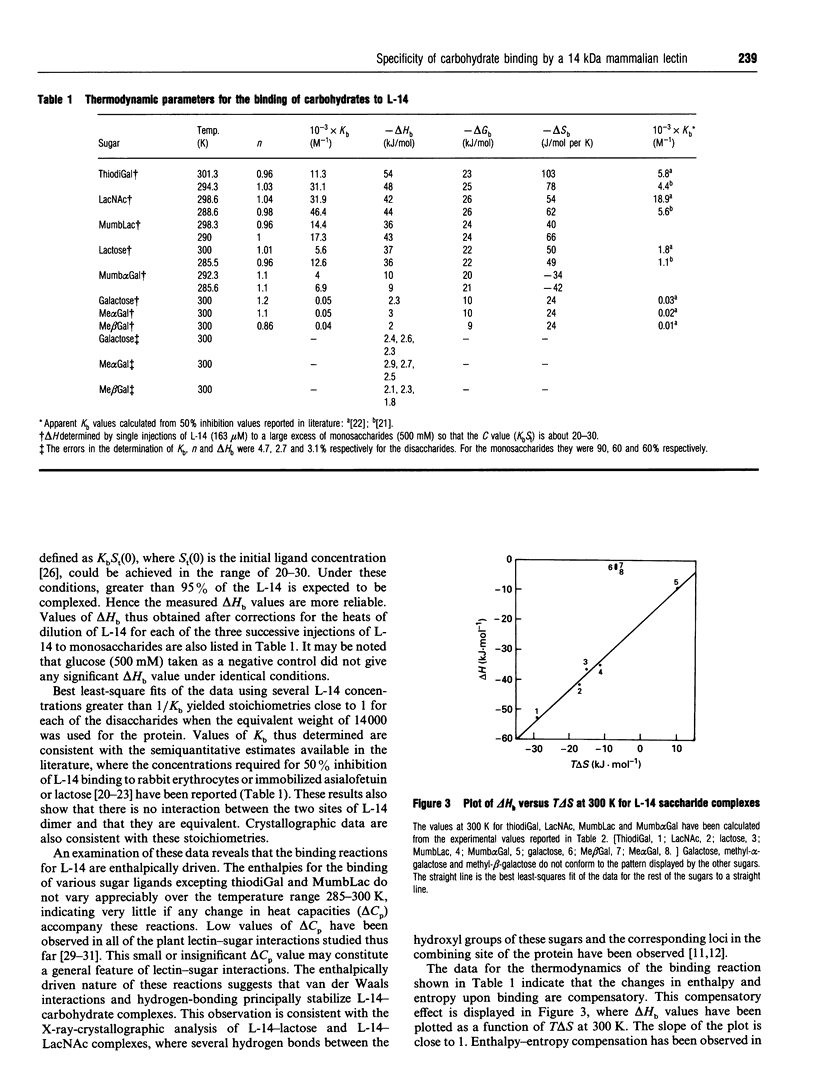
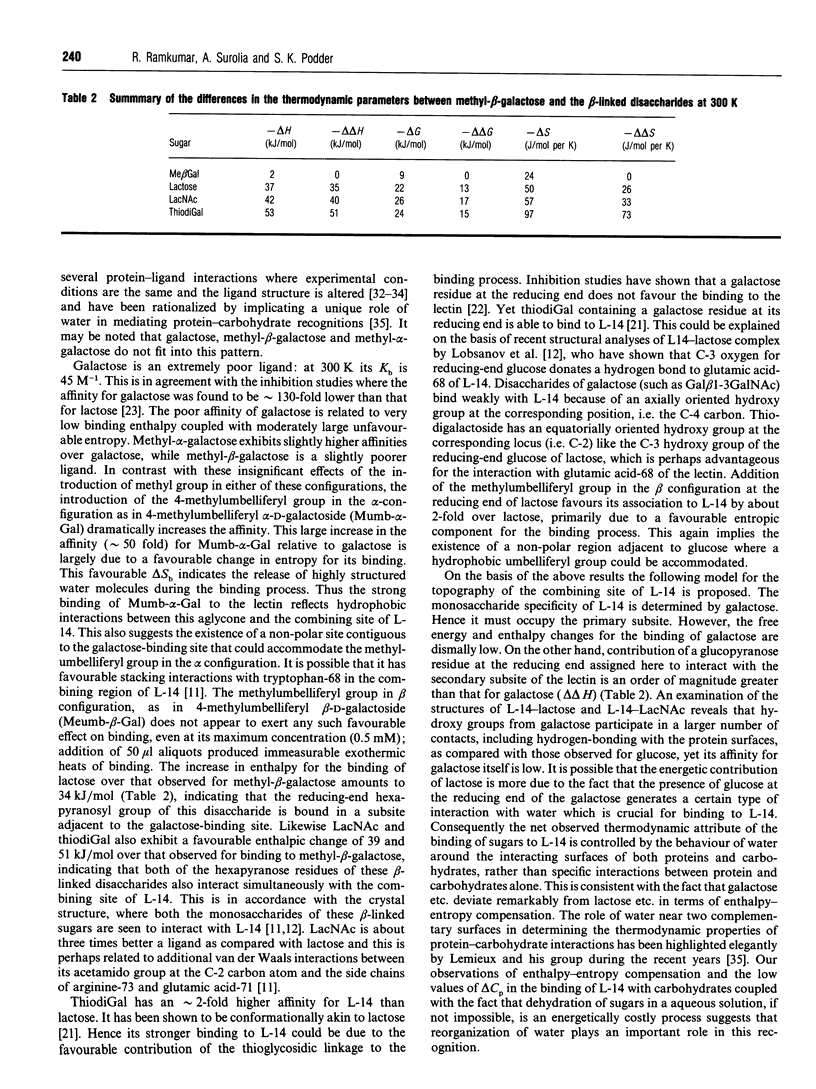
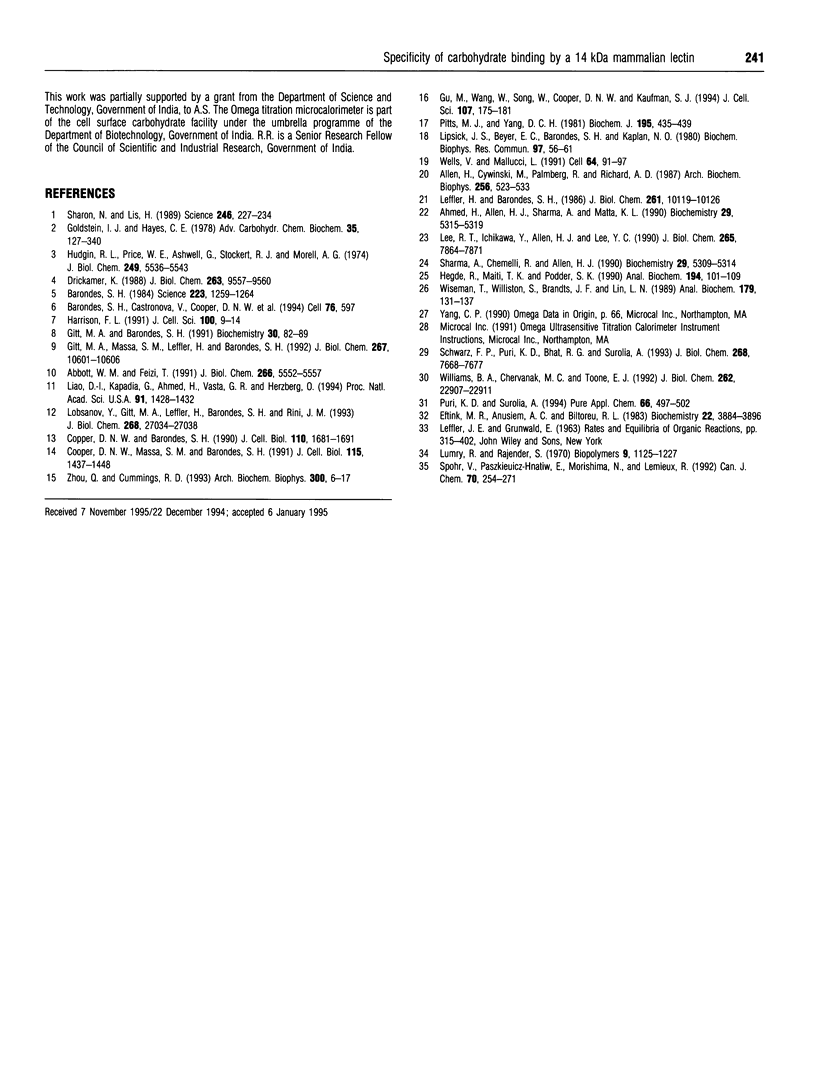
Selected References
These references are in PubMed. This may not be the complete list of references from this article.
- Abbott W. M., Feizi T. Soluble 14-kDa beta-galactoside-specific bovine lectin. Evidence from mutagenesis and proteolysis that almost the complete polypeptide chain is necessary for integrity of the carbohydrate recognition domain. J Biol Chem. 1991 Mar 25;266(9):5552–5557. [PubMed] [Google Scholar]
- Ahmed H., Allen H. J., Sharma A., Matta K. L. Human splenic galaptin: carbohydrate-binding specificity and characterization of the combining site. Biochemistry. 1990 Jun 5;29(22):5315–5319. doi: 10.1021/bi00474a015. [DOI] [PubMed] [Google Scholar]
- Allen H. J., Cywinski M., Palmberg R., DiCioccio R. A. Comparative analysis of galactoside-binding lectins isolated from mammalian spleens. Arch Biochem Biophys. 1987 Aug 1;256(2):523–533. doi: 10.1016/0003-9861(87)90610-2. [DOI] [PubMed] [Google Scholar]
- Barondes S. H., Castronovo V., Cooper D. N., Cummings R. D., Drickamer K., Feizi T., Gitt M. A., Hirabayashi J., Hughes C., Kasai K. Galectins: a family of animal beta-galactoside-binding lectins. Cell. 1994 Feb 25;76(4):597–598. doi: 10.1016/0092-8674(94)90498-7. [DOI] [PubMed] [Google Scholar]
- Barondes S. H. Soluble lectins: a new class of extracellular proteins. Science. 1984 Mar 23;223(4642):1259–1264. doi: 10.1126/science.6367039. [DOI] [PubMed] [Google Scholar]
- Cooper D. N., Barondes S. H. Evidence for export of a muscle lectin from cytosol to extracellular matrix and for a novel secretory mechanism. J Cell Biol. 1990 May;110(5):1681–1691. doi: 10.1083/jcb.110.5.1681. [DOI] [PMC free article] [PubMed] [Google Scholar]
- Drickamer K. Two distinct classes of carbohydrate-recognition domains in animal lectins. J Biol Chem. 1988 Jul 15;263(20):9557–9560. [PubMed] [Google Scholar]
- Eftink M. R., Anusiem A. C., Biltonen R. L. Enthalpy-entropy compensation and heat capacity changes for protein-ligand interactions: general thermodynamic models and data for the binding of nucleotides to ribonuclease A. Biochemistry. 1983 Aug 2;22(16):3884–3896. doi: 10.1021/bi00285a025. [DOI] [PubMed] [Google Scholar]
- Gitt M. A., Barondes S. H. Genomic sequence and organization of two members of a human lectin gene family. Biochemistry. 1991 Jan 8;30(1):82–89. doi: 10.1021/bi00215a013. [DOI] [PubMed] [Google Scholar]
- Gitt M. A., Massa S. M., Leffler H., Barondes S. H. Isolation and expression of a gene encoding L-14-II, a new human soluble lactose-binding lectin. J Biol Chem. 1992 May 25;267(15):10601–10606. [PubMed] [Google Scholar]
- Goldstein I. J., Hayes C. E. The lectins: carbohydrate-binding proteins of plants and animals. Adv Carbohydr Chem Biochem. 1978;35:127–340. doi: 10.1016/s0065-2318(08)60220-6. [DOI] [PubMed] [Google Scholar]
- Gu M., Wang W., Song W. K., Cooper D. N., Kaufman S. J. Selective modulation of the interaction of alpha 7 beta 1 integrin with fibronectin and laminin by L-14 lectin during skeletal muscle differentiation. J Cell Sci. 1994 Jan;107(Pt 1):175–181. doi: 10.1242/jcs.107.1.175. [DOI] [PubMed] [Google Scholar]
- Harrison F. L. Soluble vertebrate lectins: ubiquitous but inscrutable proteins. J Cell Sci. 1991 Sep;100(Pt 1):9–14. doi: 10.1242/jcs.100.1.9. [DOI] [PubMed] [Google Scholar]
- Hegde R., Maiti T. K., Podder S. K. Purification and characterization of three toxins and two agglutinins from Abrus precatorius seed by using lactamyl-Sepharose affinity chromatography. Anal Biochem. 1991 Apr;194(1):101–109. doi: 10.1016/0003-2697(91)90156-n. [DOI] [PubMed] [Google Scholar]
- Hudgin R. L., Pricer W. E., Jr, Ashwell G., Stockert R. J., Morell A. G. The isolation and properties of a rabbit liver binding protein specific for asialoglycoproteins. J Biol Chem. 1974 Sep 10;249(17):5536–5543. [PubMed] [Google Scholar]
- Lee R. T., Ichikawa Y., Allen H. J., Lee Y. C. Binding characteristics of galactoside-binding lectin (galaptin) from human spleen. J Biol Chem. 1990 May 15;265(14):7864–7871. [PubMed] [Google Scholar]
- Leffler H., Barondes S. H. Specificity of binding of three soluble rat lung lectins to substituted and unsubstituted mammalian beta-galactosides. J Biol Chem. 1986 Aug 5;261(22):10119–10126. [PubMed] [Google Scholar]
- Liao D. I., Kapadia G., Ahmed H., Vasta G. R., Herzberg O. Structure of S-lectin, a developmentally regulated vertebrate beta-galactoside-binding protein. Proc Natl Acad Sci U S A. 1994 Feb 15;91(4):1428–1432. doi: 10.1073/pnas.91.4.1428. [DOI] [PMC free article] [PubMed] [Google Scholar]
- Lipsick J. S., Beyer E. C., Barondes S. H., Kaplan N. O. Lectins from chicken tissues are mitogenic for Thy-1 negative murine spleen cells. Biochem Biophys Res Commun. 1980 Nov 17;97(1):56–61. doi: 10.1016/s0006-291x(80)80133-1. [DOI] [PubMed] [Google Scholar]
- Lobsanov Y. D., Gitt M. A., Leffler H., Barondes S. H., Rini J. M. X-ray crystal structure of the human dimeric S-Lac lectin, L-14-II, in complex with lactose at 2.9-A resolution. J Biol Chem. 1993 Dec 25;268(36):27034–27038. doi: 10.2210/pdb1hlc/pdb. [DOI] [PubMed] [Google Scholar]
- Lumry R., Rajender S. Enthalpy-entropy compensation phenomena in water solutions of proteins and small molecules: a ubiquitous property of water. Biopolymers. 1970;9(10):1125–1227. doi: 10.1002/bip.1970.360091002. [DOI] [PubMed] [Google Scholar]
- Pitts M. J., Yang D. C. Mitogenicity and binding properties of beta-galactoside-binding lectin from chick-embryo kidney. Biochem J. 1981 May 1;195(2):435–439. doi: 10.1042/bj1950435. [DOI] [PMC free article] [PubMed] [Google Scholar]
- Schwarz F. P., Puri K. D., Bhat R. G., Surolia A. Thermodynamics of monosaccharide binding to concanavalin A, pea (Pisum sativum) lectin, and lentil (Lens culinaris) lectin. J Biol Chem. 1993 Apr 15;268(11):7668–7677. [PubMed] [Google Scholar]
- Sharma A., Chemelli R., Allen H. J. Human splenic galaptin: physicochemical characterization. Biochemistry. 1990 Jun 5;29(22):5309–5314. doi: 10.1021/bi00474a014. [DOI] [PubMed] [Google Scholar]
- Sharon N., Lis H. Lectins as cell recognition molecules. Science. 1989 Oct 13;246(4927):227–234. doi: 10.1126/science.2552581. [DOI] [PubMed] [Google Scholar]
- Wells V., Mallucci L. Identification of an autocrine negative growth factor: mouse beta-galactoside-binding protein is a cytostatic factor and cell growth regulator. Cell. 1991 Jan 11;64(1):91–97. doi: 10.1016/0092-8674(91)90211-g. [DOI] [PubMed] [Google Scholar]
- Williams B. A., Chervenak M. C., Toone E. J. Energetics of lectin-carbohydrate binding. A microcalorimetric investigation of concanavalin A-oligomannoside complexation. J Biol Chem. 1992 Nov 15;267(32):22907–22911. [PubMed] [Google Scholar]
- Wiseman T., Williston S., Brandts J. F., Lin L. N. Rapid measurement of binding constants and heats of binding using a new titration calorimeter. Anal Biochem. 1989 May 15;179(1):131–137. doi: 10.1016/0003-2697(89)90213-3. [DOI] [PubMed] [Google Scholar]
- Zhou Q., Cummings R. D. L-14 lectin recognition of laminin and its promotion of in vitro cell adhesion. Arch Biochem Biophys. 1993 Jan;300(1):6–17. doi: 10.1006/abbi.1993.1002. [DOI] [PubMed] [Google Scholar]


